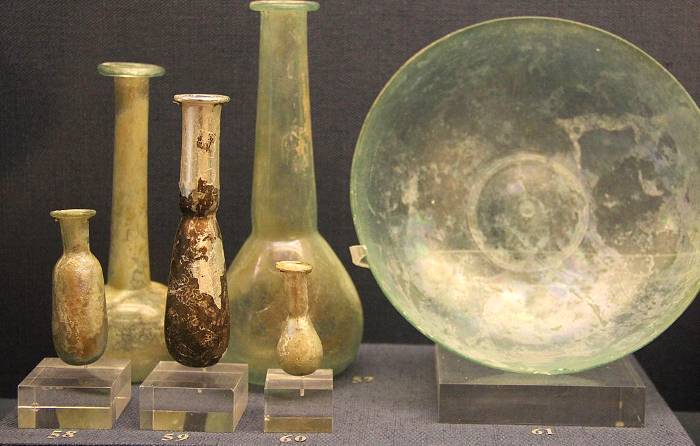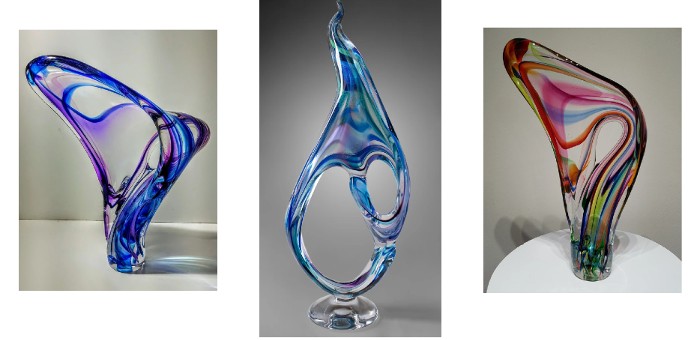
What is glass?

Photo of Roman glass display provided by Wiki Media.
Glass is a non-crystalline solid that is usually transparent, brittle, and chemically inert. It has widespread practical, technological, and decorative purposes. Glass is used for a variety of products including window panes, tableware, and optics.
History of glass
Glass has been around for thousands of years. It is thought that Phoenicians discovered glass while cooking in big pots over fires built on sandy beaches, but no one really knows for sure how glass was invented.
We do know that man-made glass first appeared in the Middle East where molten glass was wrapped around a small mold. The early Egyptians also made glass around 1400 B.C. They created glass beads for jewelry and other decorative objects. They invented a method of glass making called core forming.
Roman glass makers appeared on the scene.
After seeing what the Egyptians were doing, the Romans developed their own techniques for making glass.
Fusing and slumping (with glass canes), flame working, and lampworking are also ancient forms of Roman glass making (from around 500 B.C.)
In the 1st century B.C., a type of glassed marked Ennion appeared in Jerusalem. Ennion could have been the designer, the glassmaker, or a rich Roman that liked pretty things and hired craftsmen to do his bidding. No one knows for sure what part Ennion played in the glassmaking, but this glass was made in a new way.
Ennion glass was made using a method known as mold-blowing, shaping glass by blowing the thick taffy like “liquid” into a big bubble inside a mold. This was probably the first blown glass. It made it possible to create larger sized vessels quickly with lots of detail. Don't you know those early glassmakers were surprised to find that glass could be inflated (just like a balloon)?
Little is known about early glassmaking techniques because everything was kept secret. Families passed secrets to the next generation and different styles were born over the centuries.
The Romans spread the art of glass making all over Europe. Italy and Sweden became especially famous for their glassmaking design skills.
This video is short, but touches on the many landmark moments in the history of glass making. It is worth a watch if you are interested in glass.
American glass
Glassmaking came to the new world with the early explorers and settlers. Pressed glass became popular in the 1900's and made glassware affordable – tons were produced for households across America.
Carnival glass, elegant glass, milk glass, crystal, and depression glass were all sought after back then, and are highly collectible today. Antique glass prices can be upward of a million dollars, but lots of nice collectible pieces can still be found for pocket change at thrift stores and yard sales.
Tiffany, Steuben, and Fenton are three of the most famous American glass designers. Anchor Hocking, Blenko, Corelle, Fostoria, Hazel-Atlas, Libbey-Owens-Ford, Owens, Viking, Westmoreland, Wheaton, and many more companies have also contributed to the amazing world of American glass.
Art glass, from the USA and from around the world, is highly sought after by collectors. Some of the best pieces are in museums. Visit one if you ever get the chance.
5 top glass museums in the USA
- Museum of Glass, Tacoma, Washington
- Corning Museum of Glass, Corning, New York
- Sandwich Glass Museum, Sandwich, Maine
- Chrysler Museum of Art - Glass collection, Norfolk, Virginia
- Morse Museum - Tiffany collection, Winter Park, Florida

One of my favorite glass artists is David Goldhagen. See more of his work at Goldhagen Art Glass.
What is glass?
Glass can be both a liquid and a solid. When solid, it is both strong and fragile.
Scientists call glass a rigid liquid. Glass cools so quickly that normal crystals are not formed and a clear product is the result.
Molten glass is a form of volcanic lava or molten rock that has cooled rapidly. It is known as obsidian.
Besides volcanoes, there are other ways glass is created by natural occurrences. When lightening hits sand, sometimes a type of glass is formed. It is known as petrified lightening and looks like delicate coral.
Man made glass is created out of common materials. The main ingredient is sand. The sand is mixed with an alkaline such as pot ash so that the sand melts at a lower temperature. Then powdered lime is added for strength. Other minerals and compounds are added to get different colors of glass.
Glass can be shaped while hot by wrapping, pouring, molding, stretching, throwing, mashing, and blowing. When cool, it can be carved, sanded, cut, or enameled. There are many varied and unique techniques for creating and finishing glass objects.
Glass artists and craftspeople are called gaffers.
Gaffers are highly skilled craftsmen with years of experience. You don't become a respected gaffer overnight! Gaffers work with molten glass to create all kinds of beautiful art glass.
Most common glassware is produced in factories. Glass factories use automated equipment to churn out thousands of glassware pieces every day.
Glass is used in everything from our kitchens to space shuttles. It is 100% recyclable and is considered Earth's natural packaging. Bottles and other glass containers are used as containers for everything from soda pop and wine to neon gas.
What is crystal?
Real crystal is transparent quartz rock that is colorless or lightly tinged. Rock crystal is mined – like other rocks and minerals -- from the earth.
The crystalline solids that make up rock crystal are formed from highly organized patterns of atoms, molecules, and ions. Under a microscope, rock crystal looks like three dimensional skyscrapers extending outward in all directions. Magnified at a high enough power, crystal reminds me of New York City when viewed from space.
Clear glass is also known as crystal.
Anything that resembles quartz can be called crystal – such as clear glass. Please note that glass does not have the same structure as crystal. Glass is an amorphous solid, not crystalline.
Lead crystal
When viewed under a microscope, glass looks like a more layered, cracked version of rock crystal.
Usually when people speak of crystal, they are taking about leaded glass -- which creates a prism effect when viewed in bright light.
Lead crystal is a type of crystal glass that contains lead – as much as 40% by weight. The lead increases the working period of molten glass making it easier to create more intricate, decorative patterns.
Since there are possibilities of poisoning with the use of lead crystal in drinking glasses and goblets, crystal is now made with barium, zinc, or potassium oxide. Lead-free crystal is similar to lead crystal but does have a little less dispersive power. This lead-free crystal glass is known as crystal glass or crystalline.
Baccarat, Daum, Lalique, Steuben, Tiffany, Waterford, and Swarovski are some of the most famous crystal makers. The use of the term “crystal” is not regulated in the USA. In the European Union, labeling of crystal products is governed by the Council Directive 69/493/EEC.
Sources:
Behind the Glass: Invention in Early Glassblowing – The Road to Ennion with Bill Gudenrath
https://en.wikipedia.org/wiki/Glass
Thanks so much for reading my blog. Jan.
© 2023 website design and content by Janice Boling